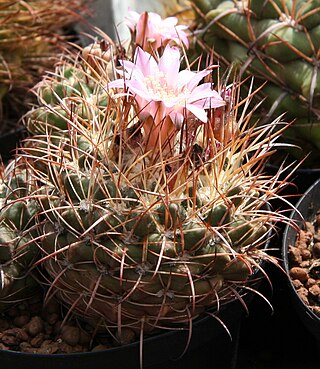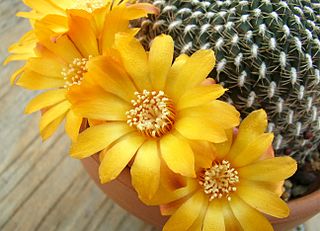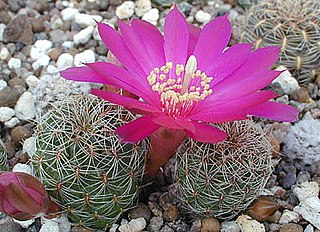
Rebutia is a genus of flowering plants in the family Cactaceae, native to Bolivia and Argentina. The limits of the genus have varied widely, depending on whether genera such as Aylostera and Weingartia are included or treated separately. As of December 2024, Plants of the World Online accepted only three species of Rebutia. A very large number of plants that have been treated in cultivation as species of Rebutia are now generally regarded as varieties, forms or synonyms of a much smaller number of species, or have been transferred to other genera. Plants treated as Rebutia are generally small, colorful cacti, globular in form, which freely produce flowers that are relatively large in relation to the body. They have no distinctive ribs, but do have regularly arranged small tubercles. They are considered fairly easy to grow and they may produce large quantities of seeds that germinate freely around the parent plant.

Ipomoea alba, known in English as tropical white morning glory, moonflower or moonvine, is a species of night-blooming morning glory, native to tropical and subtropical regions of North and South America, from Argentina to northern Mexico, Arizona, Florida and the West Indies. Though formerly classified as genus Calonyction, species aculeatum, it is now properly assigned to genus Ipomoea, subgenus Quamoclit, section Calonyction.

Brassica juncea, commonly mustard greens, brown mustard, Chinese mustard, Indian mustard, Korean green mustard, leaf mustard, Oriental mustard and vegetable mustard, is a species of mustard plant.

Weingartia is a genus in the family Cactaceae, with species native to Bolivia and Argentina. It was formerly included in Rebutia, but molecular phylogenetic evidence suggested that it was distinct from that genus. As of December 2024, it was treated as separate genus by Plants of the World Online, and recognized as an alternative generic name in the third edition of the CITES Cactaceae Checklist. It may also be treated as Rebutia subg. Weingartia.

Neowerdermannia vorwerkii, also known as achakana, is a species of cactus from high altitudes in Bolivia and northern Argentina.

Weingartia arenacea, the arenaceous crown cactus, is a species of cactus native to central Bolivia. It has been renamed Weingartia arenacea. It has gained the Royal Horticultural Society's Award of Garden Merit.

Weingartia canigueralii is a species of cactus in the genus Weingartia, native to Bolivia. It has gained the Royal Horticultural Society's Award of Garden Merit.
Weingartia cantargalloensis is a species of flowering plant in the family Cactaceae, native to Bolivia. It was first described in 2006 as Sulcorebutia cantargalloensis.

Weingartia crispata is a species of flowering plant in the family Cactaceae, native to Bolivia. It was first described by Walter Rausch in 1970 as Sulcorebutia crispata.
Weingartia fischeriana is a species of flowering plant in the family Cactaceae, endemic to Bolivia. It was first described by Karl Augustin in 1970 as Sulcorebutia fischeriana.

Weingartia heliosoides is a species of cactus in the genus Weingartia, endemic to Bolivia.

Weingartia vasqueziana is a species of flowering plant in the family Cactaceae, endemic to Bolivia. It was first described by Walter Rausch in 1970 as Sulcorebutia vasqueziana.

Weingartia mentosa, the crown cactus, is a species of cactus in the genus Weingartia, native to Bolivia. It has gained the Royal Horticultural Society's Award of Garden Merit.

Weingartia neocumingii, the Cuming crown cactus, is a species of cactus in the genus Weingartia, endemic to Bolivia. It has gained the Royal Horticultural Society's Award of Garden Merit.
Weingartia corroana is a species of flowering plant in the family Cactaceae, native to Bolivia. It was first described by Martín Cárdenas in 1951 as Weingartia pulquinensis var. corroana and then raised to a full species in 1964.
Weingartia hediniana is a species of flowering plant in the family Cactaceae, native to Bolivia. It was first described by Curt Backeberg in 1950.
Weingartia mizquensis is a species of flowering plant in the family Cactaceae, endemic to Bolivia. It was first described by Walter Rausch in 1970 as Sulcorebutia mizquensis.
Weingartia taratensis is a species of flowering plant in the family Cactaceae, native to Bolivia. It was first described by Martín Cárdenas in 1964 as Rebutia taratensis.

Weingartia cylindrica is a species of Weingartia found in Bolivia.
Weingartia tarijensis is a species of Weingartia found in Bolivia.












